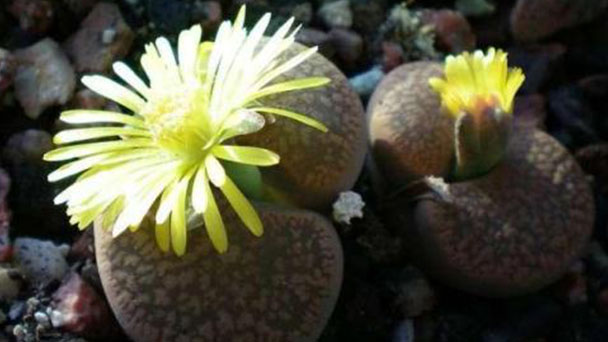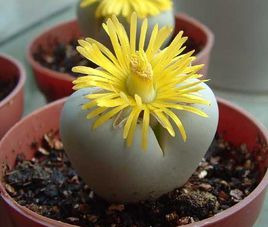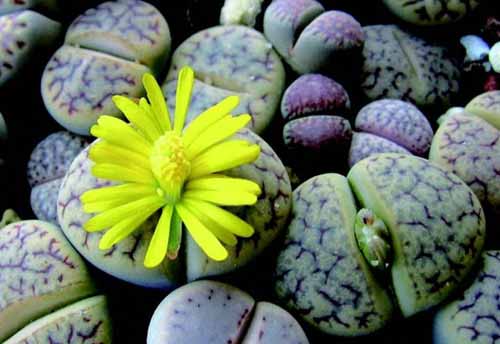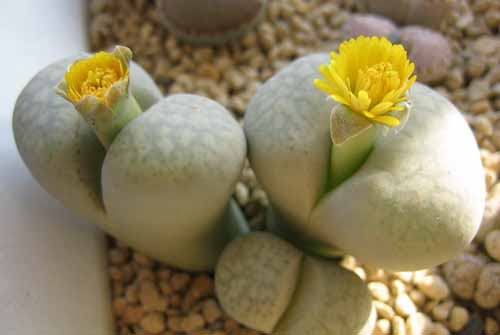Truncate living stone (Lithops pseudotruncatella) profile
Written by Maggie
Mar 17 2021

Truncate living stone (Lithops pseudotruncatella) stem is very short, often invisible, is the world famous perennial small succulent plant. Metamorphosis leaves are fleshy and thick, two pieces of opposite connection and become inverted cones, "saddle", "ball", "foot bag" and other shapes, leaf top pattern shape like branches, beautiful color. Truncate Living Stone has many varieties, each with its own characteristics. Its appearance and color resemble color pebbles, old people called "live pebble" or "pebble plant". What's even more interesting is that the color of its leaves matches the color of the soil around it to protect itself.
Truncate living stone is 2 -- 3cm tall, oval, globular leaves light grayish-brown, apex dendritic indented, brown, translucent. The stem is short, and the plant is a cone formed by two opposite fleshy leaves joining together. The flowers are golden yellow. There are many species, including 70-80 species of truncate living stone genus. Truncate living stones belong to the genus Truncate living stone (Lithops) of the family Liliaceae. The appearance and color of Truncate Living Stones are similar to pebbles, so they are also known as living stones, Truncate Living Stones, pebble plants, etc. Some varieties of Truncate Living Stone have a surface color similar to the hues of surrounding pebbles, which can be difficult to identify if they are not in bloom. Common cultivation is the sun wheel jade (L.A. Campiac); L. Eberlanzii; Amber jade (L. ella) and so on.
Truncate living stone picture

Morphological features of truncate living stone
Truncate living stone is a succulent perennial plant, 2-3cm tall, with ovoid globules, light gray-brown globular leaves, dendritic grooves at the top, brown, translucent. The stem of Truncate Living Stone is short, and the plant is a cone formed by two opposite fleshy leaves. The flowers are golden yellow.
Truncate living stones belong to the genus Truncate living stones (Lithops) of the family Truncate living stone. Truncate living stones resemble pebbles in shape and color, so they are also called living stones, Truncate living stones, pebble plants, etc. Some varieties of Truncate Living Stone have a surface color similar to the hues of surrounding pebbles, which can be difficult to identify if they are not in bloom. Common cultivation is the sun wheel jade (L.A. Campiac);L. Eberlanzii;Amber jade (L. ella) and so on.
Truncate living stone growth process is also very strange, by molting growth, by splitting to reproduce the number of heads. It takes several years for a single plant to gradually divide into clusters.In autumn, 3-4 years old Truncate Living Stone blooms in yellow, white, red, pink, purple and other colors from the middle gap of opposite leaves. Most flowers bloom in the afternoon, close in the evening, and bloom again in the afternoon of the next day. A single flower can bloom for 7-10 days. When it blooms, the flowers almost cover the whole plant and are very beautiful. When the flowers fade, they bear fruit and harvest very small seeds. Truncate Living Stone is in the shape of colored stone, colorful, small and graceful, and enjoys the reputation of "living stone".
The ecological habits of truncate living stone
Truncate Living Stone enjoys a warm, dry and sunny environment and requires shade in summer. The suitable temperature for growth is 18 ~ 24℃, to avoid low temperature and strong light. Truncate living stone is not resistant to high temperature, afraid of wet water. The overwintering temperature must be kept above 12℃. It is suitable for the growth of loose and well-drained sandy loam.
Truncate Living Stone is easy to manage and not strict to the environment. It can be grown in a common greenhouse or living room. Truncate living stone has developed a root system, so it should be cultivated in a deep basin. The basin soil can be mixed with 4 parts of leaf rot soil, 3 parts of calcareous materials (shell powder, eggshell powder, old ash wall debris, etc.) and 3 parts of river sand. Planting can not be too deep, otherwise it is easy to cause planting and wiping rot. The growth rule of Truncate living stone is that it begins to grow in spring, stops growing in high temperature season, enters dormant period in summer, continues to grow and bloom in cool autumn, and enters overwintering period after flowers fade.
Propagation of truncate living stone
Division propagation
Truncate living stone growth process is also very strange, by molting growth, by the number of division propagation. It takes several years for a single plant to gradually divide into clusters. In autumn, 3-4 years old Truncate Living Stone blooms yellow, white, red, pink, purple and other colors from the middle gap of opposite leaves. Most flowers bloom in the afternoon, close in the evening, and bloom again in the next afternoon. A single flower can bloom for 7-10 days. When it blooms, the flowers almost cover the whole plant and are very beautiful. When the flowers fade, they bear fruit and harvest very small seeds.
Seed propagation
4 seeds mature in late autumn, immediately for sowing, but also spring sowing. Because the seed is small, the seed is generally not covered with soil, the seeding pot is covered with glass. Seedlings of Truncate living stone grow to the size of corn kernels. 3-5 days after the pot can not be watered, can only spray, otherwise the ball is easy to rot. The suitable temperature for germination is 18-22℃, and germination takes 7-10 days after sowing. Seedlings are only soya-sized, slow growing and need careful management. The seedlings will take 2-3 years to bloom. Seeds are small, but seedlings in the appropriate temperature environment tolerance is strong, sowing is relatively easy to succeed.
Truncate Living Stone seedlings are difficult to maintain, like warm in winter and cool in summer climate. When new globular leaves grow in spring every year, the old globular leaves gradually shrink. In summer, the new globular leaves grow thicker and thicker, and always keep 2 globular leaves. Truncate living stone needs more moisture for a long time, but not too wet. Fertilizer every half a month 1 time, the suspension of fertilization after autumn flowering. Winter put indoor sunny place conservation, such as low room temperature, long-term shade, spherical leaf growth is not good, will gradually shrink.

How to grow and care for truncate living stone
1. Soil
Truncate Living Stone does not have strict requirements on environmental conditions, which makes cultivation and management easier. The basin soil can be mixed with 4 parts of leaf rot soil, 3 parts of calcareous materials (shell powder, eggshell powder, old ash wall debris, etc.) and 3 parts of river sand.
2. Watering
Truncate Living Stone needs more water in the growing period, but it can not be too wet. It is easy to grow moss, which affects the normal growth of spherical leaves.
3. Sunlight
Truncate Living Stone will have a more beautiful leaf color if it is maintained in a semi-shady place in summer, or if it is shaded 50%. In spring and autumn, because the temperature is not very high, it is necessary to give it direct sunlight, in order to facilitate the accumulation of nutrients for photosynthesis.In winter, put in the place that has bright light indoor maintenance.
4. Temperature
The optimal growth temperature of Truncate Living Stone is 15℃ ~ 25℃. It is afraid of high temperature and sultry heat, and it will go into hibernation when the temperature is above 33℃ in summer. Avoid cold frost, overwintering temperature needs to be kept above 10℃, in winter the temperature drops below 7℃ also into hibernation state, if the ambient temperature is close to 4℃, will die due to frostbite.
5. Fertilizer
Truncate Living Stone should be fertilized once every half month, but the fertilizer should not stain the globular leaves. Suspend fertilization after autumn flowering.
6. Insect pests
Truncate Living Stone is mainly affected by leaf spot disease and leaf rot disease, which can be sprayed with 65% Daxin WP 600 times liquid.Insect pests have ants and root knot nematode damage, using soil exchange method to reduce nematode damage.Prevent ant, usable cover basin to lie between water to conserve, make ant climbs less than tender and succulent globular leaf.
7. Repotting
The best time to re-pot is prior to its first watering with a well-drained loam-based compost being the best choice.
8. Humidity
Normal room humidity will work fine but air circulation is advisable providing it is not directly placed near a cold draft.
9. Flowering and Fragrance
When growing under good conditions, the plant will flower in mid to late summer.
White and yellow daisy-like flowers would emerge from between the leaves.
Truncate living stone species classification
Truncate living stone is a world-famous small succulent perennial plant with many varieties. There are 70-80 species of Truncate living stone genus. Truncate living stones belong to the genus Truncate living stone (Lithops) of the family Piliaceae.
The appearance and color of Truncate Living Stones are similar to pebbles, so they are also known as living stones, Truncate Living Stones, pebble plants, etc. Some varieties of Truncate Living Stone have a surface color similar to the hues of surrounding pebbles, which can be difficult to identify if they are not in bloom. Common cultivation is the sun wheel jade (L.A. Campiac);L. Eberlanzii;Amber jade (L. ella) and so on.
Truncate living stone's distribution area
Truncate Living Stone is native to the arid areas of South Africa and Southwest Africa, and is cultivated in many countries around the world. Truncate Living Stone has been cultivated in Western Europe, the United States, Japan and other places, but it has yet to be popularized in China.
Uses of truncate living stone
Ornamental value
Truncate Living Stone is small and exquisite in the shape of colorful stone, which enjoys the reputation of "living stone". The display desk is very chic and novel, which is amazing.
Truncate Living Stone is a small plant with beautiful shape and pattern, both like sheep's hooves and pebbles. It is an indoor potted plant with unique interest.
Garden use
Truncate Living Stone is a small plant with beautiful shape and pattern, both like sheep's hooves and pebbles. It is an indoor potted plant with unique interest.

Latest Updated
- Benefits of Bugleweed - 7 Science-backed Health Benefits
- Bugleweed Dangers & Side Effects - Is It Poisonous?
- How to Plant Evergreen Trees - What You Should Know
- When to Plant Evergreens - Grow Guide for Evergreen Trees
- 12 Wonderful Evergreen Shrubs for Your Garden
- 12 Popular Evergreen Plants with Pictures for Beginners
- When And How To Prune A Lilac Bush Like a Pro
- How to Grow & Care for Lilac Vine (Hardenbergia Violacea)
- Japanese Lilac Tree (Syringa Reticulata) Care & Propagation Guide
- Shumard Oak Pros and Cons - What to Know
Popular Articles
- Winter maintenance of Antirrhinum Majus
- How to Grow Terminalia Mantaly Tree
- How to Grow and Care for Crossostephium Chinense
- How to grow Antirrhinum Majus in spring
- Peristeria Elata (Dove Orchid) Profile: Info & Care Guide
- Underwatered Snake Plant (Sansevieria Trifasciata) - Signs And How To Fix
- How to Care for Brazilian Jasmine Plant (Mandevilla Sanderi)
- How to Grow & Care for Graptopetalum Purple Delight in Summer
- Rosa Chinensis (China Rose): Plant Growing & Care Tips
- How to Care for Baby Sun Rose (Aptenia Cordifolia)